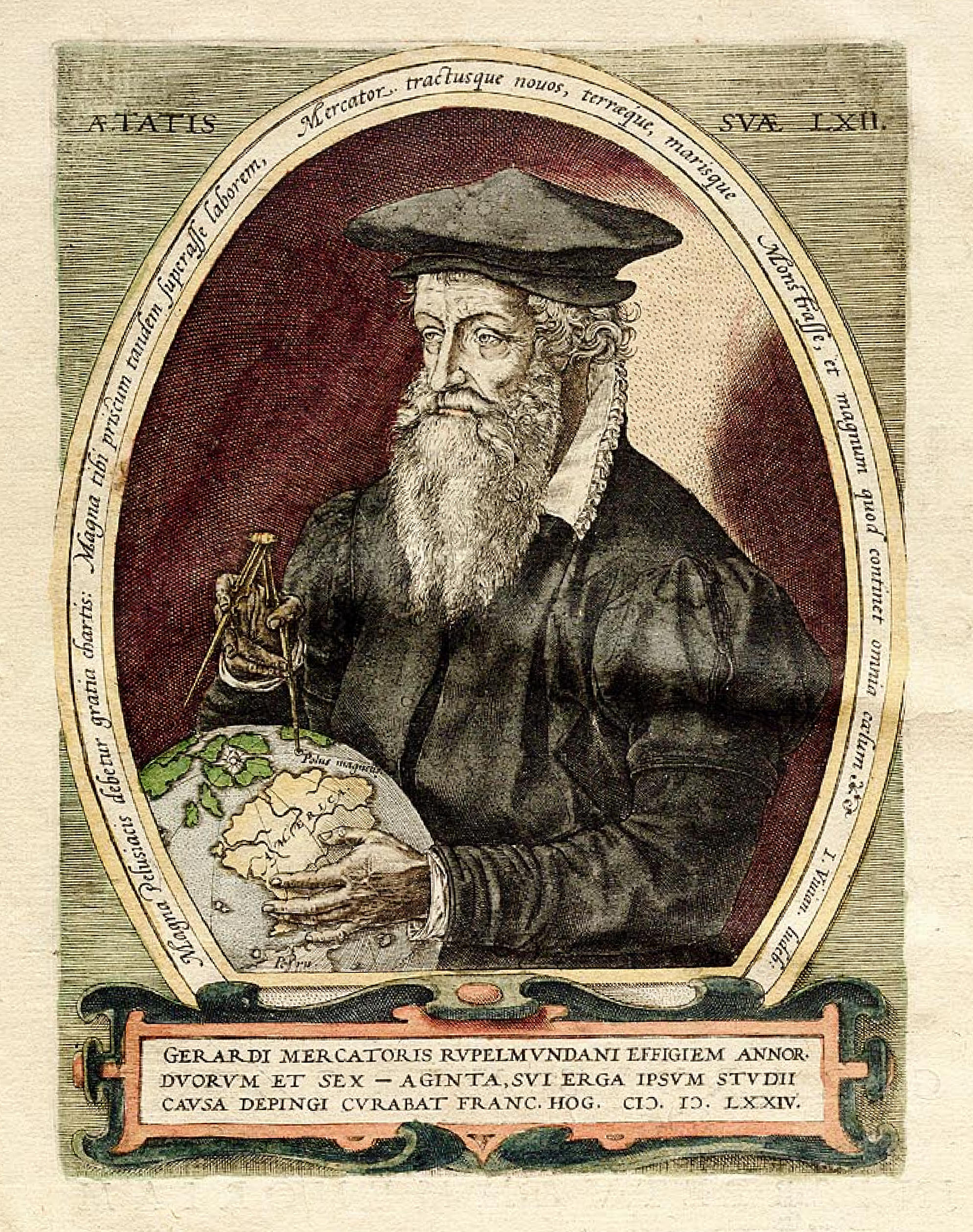by Heather R. Darsie
On 2 December 1594, Gerardus Mercator died from complications related to continues strokes. He was 82 years old. Mercator was born in the small town of Rupelmonde, not far from Antwerp, on 5 March 1512 while his parents were visiting Mercator’s uncle, a priest. He was only a few months older than Sybylla of Juelich-Cleves-Berg; his parents being from Gangelt in the duchy of Juelich-Berg and Mercator himself returned to the area later in life. Modern-day Gangelt is just barely within the Federal State of Nord Rhein-Westfalen, on the border with the Netherlands. Mercator, the youngest of seven, lived in Gangelt until sometime in 1518. Mercator’s father thought it best to move his family to Rupelmonde.
Mercator’s father died in 1526, when Mercator was about 14. Mercator’s uncle then took guardianship over Mercator, and in around 1526 sent him to Brabant to be educated in a clerical setting. The hope was that Mercator would become a priest as well. During his studies, Mercator learned to read, speak, and write Latin, along with studying the classics and learning geography. He likely learned italic script, which is sometimes called chancery cursive, during this time, too. Mercator continued his education at the University in Leuven beginning in 1530, when he was 18 years old. At 20, Mercator obtained the qualification of Magister, a teaching degree. He chose not to pursue further study in the religious fields offered at the University of Leuven, so he went to Antwerp between 1532 and 1534. It is not really known what Mercator did during this period. He left Leuven for Antwerp because of his struggles with the Church’s teaching versus what he believed from his readings of the Bible. Lutheranism was alive and well by this time, too.
By autumn 1534, Mercator resurfaced at the University of Leuven. He changed his studies to focus on astronomy, geography, and mathematics. After a rocky start, Mercator caught on to his studies quickly enough. A famous Dutch cartographer, Gemma Frisius, took Mercator under his wing. Frisius, Mercator, and Gaspar Van der Heyden joined together to make a globe, which was completed in 1536. Mercator engraved the words onto the globe using italic script; this was the first globe to feature italic script. The trio’s globe was successful, which gave Mercator a steady stream of income and brought him to the attention of the Imperial court at Brussels, which was then under the watchful eye of Maria of Austria, Holy Roman Emperor Charles V’s sister. In 1537, Mercator established himself as a cartographer in his own right by creating and engraving a map of the Holy Land by himself.

Mercator continued creating maps, gaining more and more renown. He moved to Duisburg, in the Duchy of Cleves, in 1552. Duke Wilhelm V, Anna of Cleves‘ brother, invited him there. Wilhelm intended to found the University of Duisburg, and wanted Mercator to be a professor. Mercator resumed making globes in Duisburg, although his first one was created in 1541. The university was not actually founded until 1654. However, he was an instructor at the Gymnasium in Duisburg (a Gymnasium in Germany is a college preperatory school, slightly more advanced than an American high school and somewhat akin to Sixth Form in the UK). He taught there for three years, from 1559 to 1562.
In 1569, Mercator published his Nova et aucta orbis terrae descriptio ad usum navigantium, navigational elements of which are still used today. It was this map that brought him international recognition.
Mercator enjoyed a good private life with his wife, and was safe from religious persecution in Duisburg. Mercator wed Barbara Schellekens in 1536, and the couple welcomed six children, three girls and three boys. Mercator was briefly imprisoned in 1544 for his Lutheran leanings, so being invited to the Duchy of Cleves, known to be religiously neutral, must have been a relief for the family.
Mercator died on 2 December 1594 at the age of eighty-two years old. He is buried in the Salvator Kirche in Duisburg.
Love learning about the German History or Early Modern period? Are you interested in Tudor history or Women’s history? Then check out my book, Anna, Duchess of Cleves: The King’s ‘Beloved Sister’, a new biography about Anna of Cleves told from the German perspective!

UK Hardcover, UK Paperback, UK Kindle
US Hardcover, US Paperback, US Kindle
You Might Also Like
- The Habsburgs in the Medieval and Early Modern Period
- Sebastian Cabot and the Loss of Sancti Spiritu
- The Gregorian Calendar is Adopted in 1582
- Martin Luther, Henry VIII, and the Papacy
- Tudor Currency and the Great Debasement: An Overview
Sources & Suggested Reading
- Lindgren, Uta. “Mercator, Gerhard.” Neue Deutsche Biographie. Vol. 17. Berlin: Duncker & Humblot (1994).
- Platz, Kai Thomas. “Ausgrabungen im und um das Wohnhaus Gerhard Mercators.” Archäologie im Rheinland. Darmstadt: Theiss (2013).


Wonderful and insightful. Vielen Dank fuer diesen interessanten Blog Post!
LikeLiked by 1 person
Danke für Ihre netten Wörter!
LikeLiked by 1 person
Thank you so much for a wonderful history lesson !
LikeLiked by 1 person